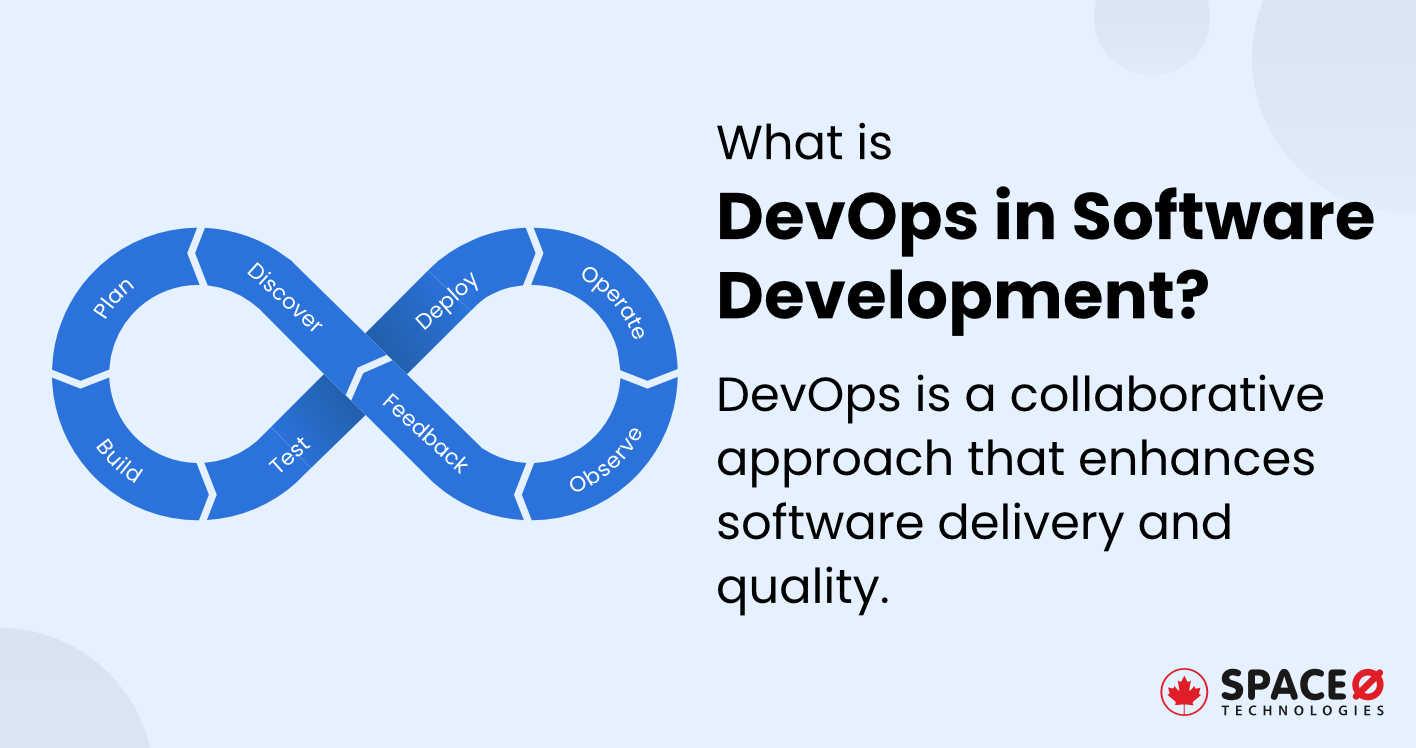
What is DevOps in Software Development? – [Definition + Methodologies]
Table of Contents
What is DevOps in Software Development?
DevOps in software development is a software development approach and cultural philosophy that emphasizes collaboration, automation, and integration between development (Dev) and operation (Ops) teams. DevOps aims to streamline and accelerate the software delivery process, enhance the quality and reliability of applications, and foster a culture of continuous improvement and shared responsibility among cross-functional teams.
Unlike traditional software development practices, the development and operations teams are no longer separated in the DevOps model. Both teams work together as a single team during the complete software development lifecycle, fostering faster software development and streamlined development processes.
However, if you want to learn more about DevOps and how its methodologies are used in software development then you can check the complete guide on what is DevOps methodology. The guide provides all basic to primary information on DevOps methodology.
Which are the Top DevOps Practices?
DevOps practices depend upon the following DevOps tools and practices:
Automates Manual Task
DevOps encourages the automation of repetitive and manual tasks such as code deployment, testing, and infrastructure provisioning. Automation reduces human error and accelerates the pace of software delivery.
Provides Continuous Integration (CI) & Continuous Delivery (CD)
Continuous integration is a software development practice where developers regularly merge their code changes into a shared repository. Automated tests are run to detect and address issues early in the development process, ensuring that code changes are always in a working state. Building upon CI, CD automates the deployment of code to various environments, including production, once it passes all tests. This enables a reliable and efficient release process, where new features and improvements can be delivered to users quickly.
Offers Continuous Deployment (CD)
As part of the DevOps element continuous deployment automates the process of deploying code changes to production environments. In continuous deployment, every code change that passes automated tests and meets the required quality criteria is automatically and immediately deployed to the production environment, without manual intervention.
Enhances Collaboration
Perhaps most importantly, DevOps is a cultural shift that emphasizes collaboration, communication, and shared ownership. Moreover, DevOps culture encourages developers to understand operational concerns, and operations teams to get involved early in the development process.
Ensures Security
Security is integrated into DevOps practices, with automated security scans and compliance checks incorporated into the pipeline. This ensures that security is not an afterthought but a continuous concern throughout the development process.
These practices are not exhaustive but are considered foundational for any organization looking to implement DevOps successfully.
10 Top Advantages of the DevOps Model in Software Development
Here are the advantages of the DevOps Model in software development:
Accelerates Software Delivery
DevOps practices, rooted in agile software development methodologies. If you are not sure about Agile, check this article to know the definition of agile software development methodology. DevOps significantly reduces the time it takes to go from code committed to successfully running in production. This enables faster feature delivery and a quicker response to market changes.
Increases Frequency of Releases
By encouraging frequent and small releases, DevOps minimizes the risk associated with large, infrequent deployments. This agile approach allows for quicker adaptation to user feedback and market demands.
Improves Collaboration
DevOps breaks down the silos between development and operations teams, fostering a culture of collaboration and open communication. This enhanced collaboration leads to more efficient problem-solving and minimizes misunderstandings.
Enhances the Quality of Software
Through automated testing and continuous integration, DevOps practices help identify and address issues early in the development process. This results in more reliable and higher-quality software products.
Reduces Failure Rate
DevOps practices, when integrated with agile software development methodology, help in catching and fixing problems early. This significantly reduces the likelihood of critical failures or outages in production environments.
Enhances Scalability
Infrastructure as Code (IaC) allows for automated provisioning and scaling of infrastructure resources. This makes it easier to handle increased workloads and adapt to traffic spikes without manual intervention.
Provides Consistency Across Environments
IaC ensures that infrastructure configurations are consistent across different environments. This eliminates the notorious “it works on my machine” problem and improves the reliability of both development and testing phases.
Faster Issue Resolution
Continuous monitoring, automated testing, and rapid feedback loops enable quicker identification and resolution of issues. This leads to a more resilient system and better user experience.
Brings Cost Efficiency
DevOps practices, particularly automation, lead to more efficient resource utilization. This results in cost savings as organizations can optimize their infrastructure and streamline various processes.
Customer-Centric Approaches
DevOps focuses on delivering value to the end-users. Frequent releases and the ability to quickly respond to user feedback result in a more customer-centric approach to software development.
To delve deeper into the foundational principles that make these advantages possible, you may want to explore various software development methodologies that align with DevOps practices.
This blog contains 11 different types of software development methodologies that incorporate DevOps practices.
What is DevOps Workflow?
Here are the DevOps workflows that are practiced during software development.
- Planning:The workflow begins with planning, where a DevOps team and multiple developers collaborate to define project goals, requirements, and timelines. They prioritize tasks and features and create a roadmap for development.
- Coding:Developers write and review code based on the project requirements. They use version control systems like Git to track changes and collaborate with team members. Continuous integration and continuous delivery are employed to merge code frequently and ensure its quality.
- Building:In this stage, code is compiled or built into executable software. DevOps engineers use build automation tools to streamline this process, ensuring consistency and reducing manual errors.
- Testing:Automated testing is a critical phase in the DevOps workflow. This includes unit testing, integration testing, and end-to-end testing. Continuous testing helps identify and address issues early in the development cycle and provides quality assurance.
- Deployment:Once code passes testing, it is deployed to various environments, including development, staging, and production. Deployment automation tools, like Jenkins or Kubernetes, play a crucial role in this stage of the DevOps lifecycle to ensure a reliable and consistent deployment process.
- Monitoring:Real-time monitoring of applications and infrastructure is ongoing. Monitoring tools track system performance, detect anomalies, and trigger alerts in case of issues. This allows for proactive problem-solving and rapid response to incidents.
DevOps agile practices streamline the software development process. These practices have similarities with Lean. If you are wondering about Lean, here is a definition of Lean. The main goal of DevOps is to improve teamwork between software development and IT operations, making software delivery faster and more reliable.
All our projects are secured by NDA
100% Secure. Zero Spam
*All your data will remain strictly confidential.
Trusted by


Bashar Anabtawi
Canada
“I was mostly happy with the high level of experience and professionalism of the various teams that worked on my project. Not only they clearly understood my exact technical requirements but even suggested better ways in doing them. The Communication tools that were used were excellent and easy. And finally and most importantly, the interaction, follow up and support from the top management was great. Space-O not delivered a high quality product but exceeded my expectations! I would definitely hire them again for future jobs!”

Canada Office
2 County Court Blvd., Suite 400,
Brampton, Ontario L6W 3W8
Phone: +1 (437) 488-7337
Email: sales@spaceo.ca




